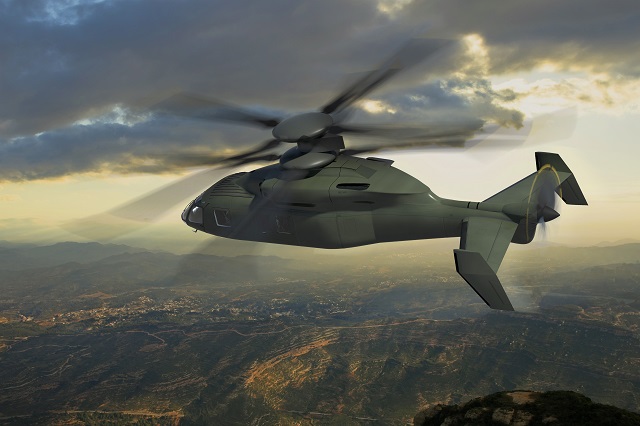Boeing is banking on its partnership with Sikorsky on the SB-1 Defiant demonstrator to help usher in the next generation of rotorcraft for Army but still anticipates that its long-serving AH-64 Apaches and CH-47 Chinooks will continue to dominate the skies out to 2060.
The SB-1 Boeing and Sikorsky are developing for the Army’s Joint Multi-Role (JMR) technology demonstration programme is expected to fly in the third quarter of 2017 at West Palm Beach in Florida.
The propeller-pushed, lift-offset coaxial aircraft is being developed alongside the Bell Helicopter-Lockheed Martin V-280 Valor, a tilt-rotor design, to inform way ahead in the medium-weight class of the Army’s Future Vertical Lift programme. If successfully validated in testing, a Defiant or Valor type of rotorcraft would start replacing US Apache and Black Hawk helicopters in the 2030s.
The company released a new video this week showing how the Defiant is expected to operate.
Speaking at press tour at Boeing’s rotorcraft manufacturing facility in Philadelphia, the company’s director of future vertical lift at Phantom Works, Pat Donnelly, says the Army wants a speedy, multi-purpose aircraft that flies faster and farther than a traditional helicopter and carries more payload, but must “operate like a helicopter and cost like a helicopter.”
“We are helping the government decide what they want for future vertical lift-medium,” Donnelly says. “They’ve put together a requirements list that’s exhaustive. What we’re doing in our SB-1 Defiant is helping them understand what the implications of any one of those design features does to the aircraft.”

The SB-1 is designed with stiff, counter-rotating blades mounted close together to reduce drag. The blades will slow as the aircraft is propelled to speeds of more than 250kt, roughly 90kt faster than a UH-60 Black Hawk. Donnelly says the propeller reverses pitch to slow the aircraft and even act as a parachute.
“There are advantages to the tilt-rotors, there’s advantages to the coaxial,” he says. “A tilt-rotor is a more mature platform, but we are relying heavily on what Sikorsky has done in this environment. They flew the X2 to 250kt about four or five years ago, and they’re going to fly their Raider.”
Boeing and Sikorsky are 50-50 joint partners on the SB-1 programme, which will benefit from Sikorsky's separate development of the S-97 Raider, also a rigid coaxial rotorcraft prototype. The Raider conducted its first flight this week and is built to cruise at 240kt.
“We’re pursuing our vehicle in our [coaxial] configuration because we believe it buys helicopter capability as well as speed,” Donnelly says. “The focus of our aircraft is its agility at low speeds like a conventional helicopter. We believe for the requirements as specified a couple of years ago, this configuration is the best.”
At an earlier press briefing, Boeing said its CH-47 Chinooks and AH-64 Apaches will remain in production through 2020 at least, depending on future sales. The Army expect to keep flying both aircraft types through 2060, by which time its Future Vertical Lift programme is expected to deliver a replacement in both mission areas.
There are approximately 850 Chinooks currently in operation globally, and Boeing has delivered more than 2,100 Apaches since their introduction in 1984. The company says the US government will need approximately 4,000 future vertical lift platforms in the future to replace its legacy helicopter fleets.
“We fly in 2017, and [we’re] probably flying for about one year,” Donnelly says, noting that the Army will consider the SB-1 and V-280 designs in an analysis of alternatives before publishing its final medium-class Future Vertical Lift requirements document. Developing a heavy-lift platform to replace the Chinook is a longer-term priority for the Army.
In addition to its Joint Multi-Role programme, Boeing hopes to develop a next-generation vertical lift platform based off its Phantom Swift, a ducted fan tilt-rotor aircraft.
Donnelly says Phantom Swift is designed to be much more efficient in hover than the SB-1, and reach cruise speeds of 300kt to 400kt.
Boeing expects to complete its preliminary design later this year before the US Defense Advanced Research Projects Agency selects one of four competing aircraft designs to carry forward. Donnelly says the aircraft will be autonomous but that is not the main focus of the competition.
Source: FlightGlobal.com






















